
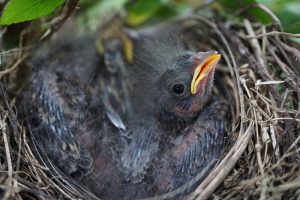
As the days grow warmer and the landscape ripples with color, a growing treetop chorus drives the message home—spring is here, and new life is thriving.
The show begins sometime in March, as hatching insects and growing plants allow the hardy songbird species that have braved winter in the Smokies to shift focus from their own survival to that of the species as a whole. It’s time to mate, and time to nest.
“One of the advantages of being a year-round resident is they often get to be the first ones there when the conditions are right for them to start getting enough food to reproduce,” said Julianne Geleynse, science communicator for Great Smoky Mountains National Park.
These birds—Carolina chickadees, northern cardinals, Carolina wrens and eastern towhees, to name a few—are the first to start staking out a territory. While some species maintain their turf throughout the winter, most boundaries break down during the cold season. When spring arrives, males spend their time flitting around the borders of their newly established kingdom, belting out songs that sound delicately whimsical to human ears but send a strong message to their peers.
“That song helps the females to find the males and check out the quality of their territory. Female birds can be very choosy. It also tells other males, ‘This my spot. I have claimed it, stay out of my territory,’” Geleynse said.
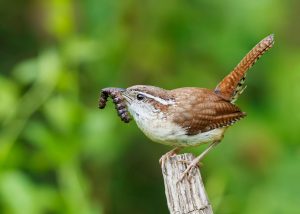
The females take it all in—the brightness of his plumage, the vigor of his song, the desirability of the territory he’s chosen—and they make a choice. Each factor says something about the male’s vitality, genetic strength, and ability to father offspring that will survive to raise chicks of their own. The symphony of chirps and trills that fills the April air could be translated as series of high-stakes negotiations, complete with threats, bribes, and professions of love.
The performance only grows richer as the weeks wear on. By the end of the first week in May, many resident birds have already finished raising their first nest of chicks. But migrant species, which appear in ever-larger numbers throughout April, have just finished traveling from their winter refuges in Central and South America. The males arrive first, their bright breeding plumage decorating the treetops with shining jewels of color and their songs adding new harmonies to the unfolding symphony in the Smokies. As do resident birds, the migrant males mark their domain in song.
“If males want to mate, they have to have a territory,” said Barbara Ballentine, an ornithologist and associate professor of biology at Western Carolina University.
Without a territory worthy of one of the females arriving from the south, a male bird is a genetic dead end. So these warblers, veerys, scarlet tanagers, and indigo buntings give it their all, singing their hearts out and fighting with any male that tries to encroach.
As to what piece of land is most likely to entice a lady bird, that varies immensely from species to species. Some want fields, and others deep forest. Some build their nests in tree cavities, and others in dense bushes. Some feed their young on larvae, others on adult insects. The ideal nesting site can mean as many different things as there are bird species in the Smokies—and so far, that tally is 254, according to Discover Life in America.
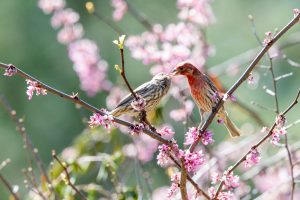
But not all 254 species recorded in the Smokies breed here. Some migrant birds are just passing through, looking for a safe place to rest and gorge before pressing on toward a destination farther north. For these species, food, not habitat, is the most important consideration.
“They’re really going to be using the part of the park where food is available,” said Geleynse.
During early spring, the still-chilly higher elevations will be mostly bereft of migrants, while lower-lying areas with fields and forest edges are popular spots—bird density tends to be higher in these edge habitats than in the depths of the forest. Good places to spot early spring migrants include Sugarlands Visitor Center, Cades Cove, Cataloochee, and Elkmont through Daisy Town and Little River Trail, Geleynse said.
As the season unfolds, that equation changes.
“One of the nice things around here for birdwatchers is you can go back in time,” said Ballentine.
Cruising the Blue Ridge Parkway or climbing Newfound Gap Road through the Smokies, the clock rewinds. Birds are active in places they weren’t earlier in the season, and birding is more fun than in the further-along lower elevations.
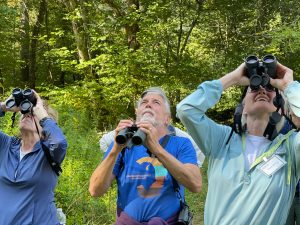
“What’s really cool about this time of year is that all the migrants coming through are in their breeding plumage, so the males are bright and shiny and colorful,” said Ballentine. “They’re pretty easy to identify, and they’re easier to see a lot of times because they’re coming through before all the trees have fully leafed out.”
Birdwatching offers more than just recreation. It’s a gateway to understanding the crucial role these beautiful creatures play in the larger ecosystem—and the peril their populations face.
“We’re losing birds, especially migrants, at alarming rates,” said Ballentine.
A 2019 research article from the journal Science drew from several long-term datasets to find that the number of birds in the United States and Canada had fallen by nearly 3 billion since 1970, a decline of 29 percent. Bird counts haven’t fallen much in the Smokies, said Geleynse, both because the park remains undeveloped and because birds displaced by human activity outside the park are seeking refuge within it.
Some of the reasons for population decline are difficult to address. For example, habitat destruction in migrant species’ Central and South American wintering grounds can have a big impact on populations in the United States and Canada, but addressing those issues across national boundaries is difficult. It’s hard enough to do at home, where new development continually paves over the places birds once relied on to find food and raise families.
But other factors are “easily fixable,” said Ballentine. These include keeping pet cats inside, as housecats kill billions of birds each year, and taking measures to prevent bird strikes on windows, which kill at least 3 billion birds annually.
“Think about the canary in the coal mine,” said Geleynse. “If all of the birds start disappearing, that’s telling us, ‘Hey, there’s something wrong with our environment.’”
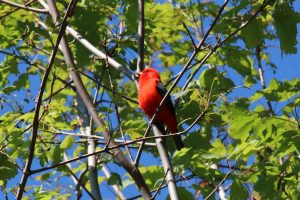
The world can get better for birds one backyard at a time. The easiest way to start is by providing a birdfeeder and water, filled up clean every day, and reducing reflective surfaces on windows, keeping birds from running into them. Next up is planting seed- and fruit-bearing native species. Finally, Geleynse suggests replacing grass, which has very little value for birds or other creatures, with an array of native plants that benefit birds.
Learning more about birds is another way to help. To get started, purchase a pair of binoculars (a decent pair costs about $100); download the Merlin app from Cornell Lab of Ornithology, which identifies birds by sound; and join a birdwatching group.
Communities surrounding the park offer a variety of birdwatching groups and opportunities. In North Carolina, regular group trips include Haywood County Recreation and Parks’ monthly bird walks; the Franklin Bird Club’s 8 a.m. Wednesday walks in Macon County starting April 17; Sylva-based Birders of the Tuckaseegee Watershed’s Friday evening walks throughout the Tuckaseegee Watershed, 6 p.m. to dusk in April and 6:30 p.m. to dusk May through August; and Asheville-based Blue Ridge Audubon’s walks at 8 a.m. most Saturdays. In Tennessee, opportunities include Knoxville Area Birding Group’s various bird walks and educational meetings in Knoxville; birding events at Seven Islands State Birding Park in Kodak; and regular birding programs at Ijams Nature Center in Knoxville.
“The more that you know and the more that you appreciate them,” Geleynse said, “the more you’ll care, and the more you’ll likely do to protect them.”
Subscribe to get the latest posts sent to your email.
The Great Smokies Welcome Center is located on U.S. 321 in Townsend, TN, 2 miles from the west entrance to Great Smoky Mountains National Park. Visitors can get information about things to see and do in and around the national park and shop from a wide selection of books, gifts, and other Smokies merchandise. Daily, weekly, and annual parking tags for the national park are also available.